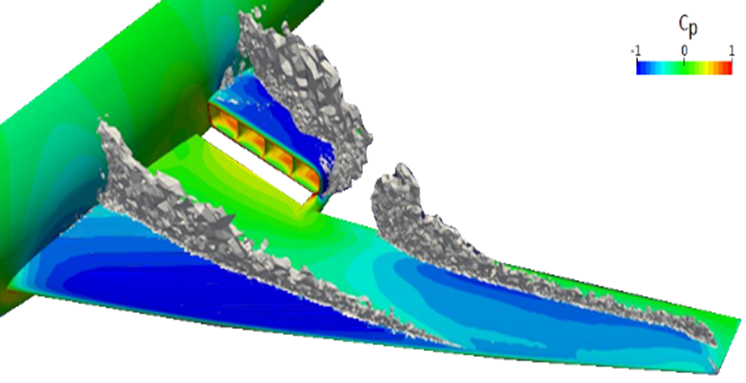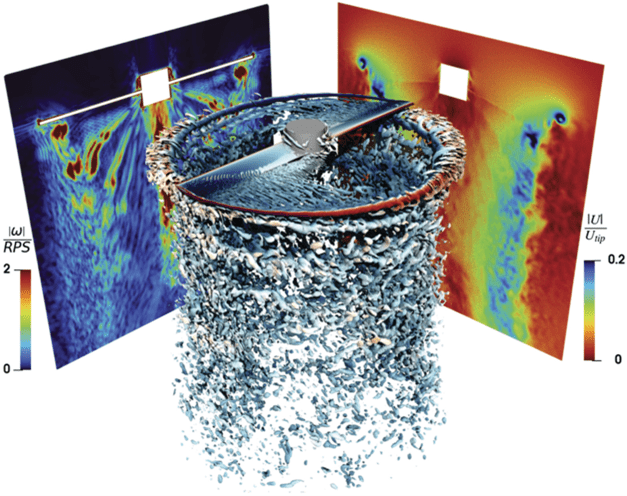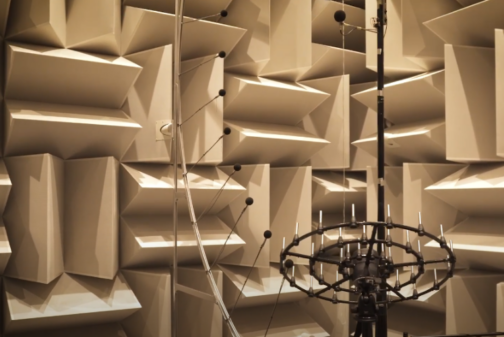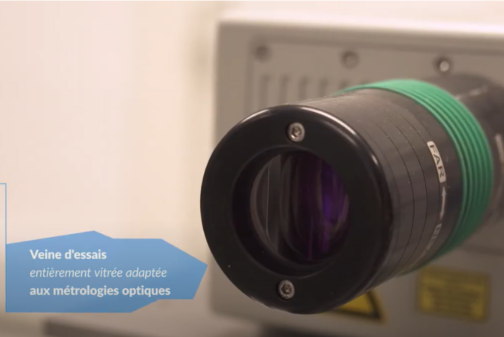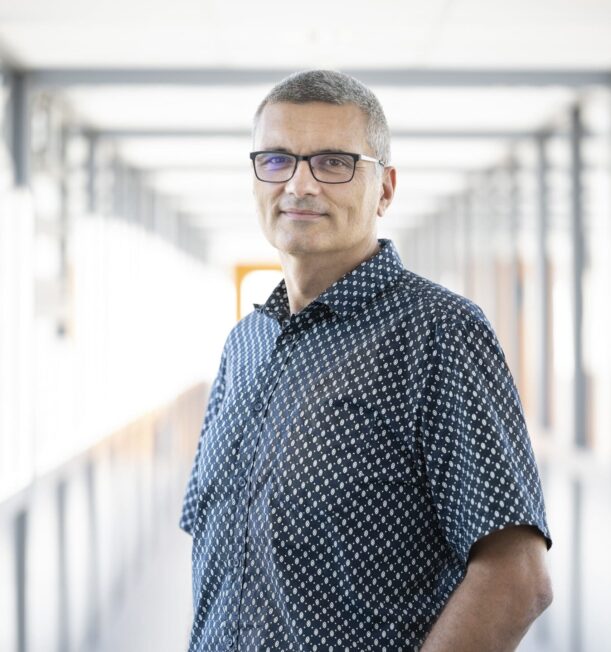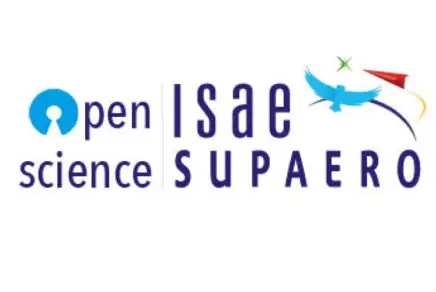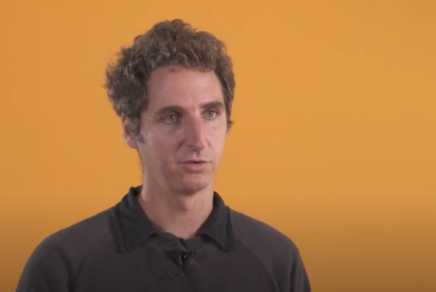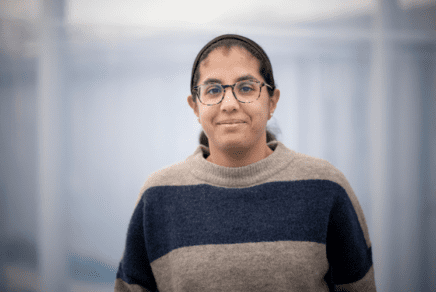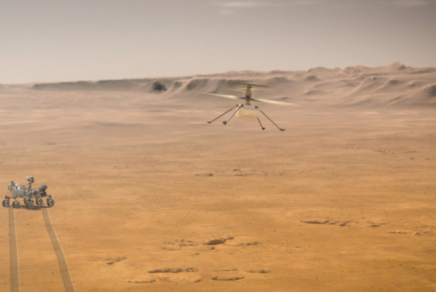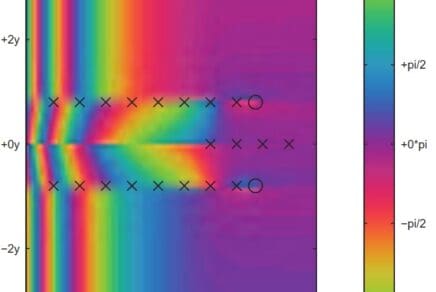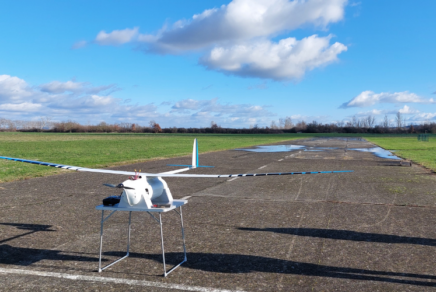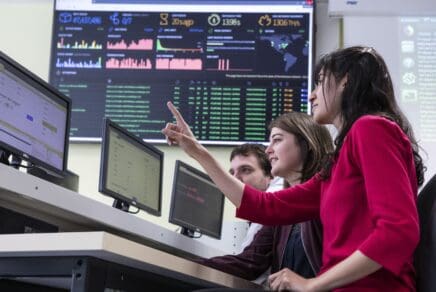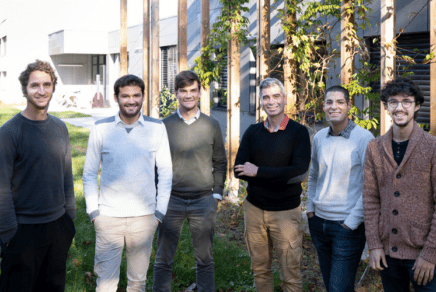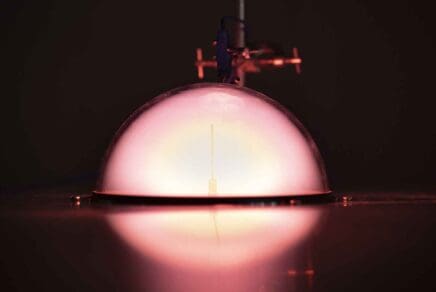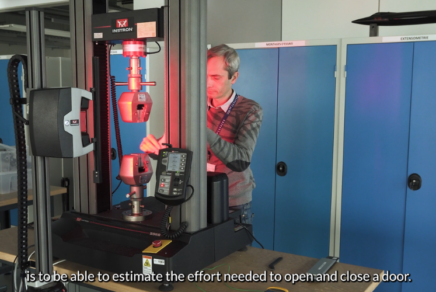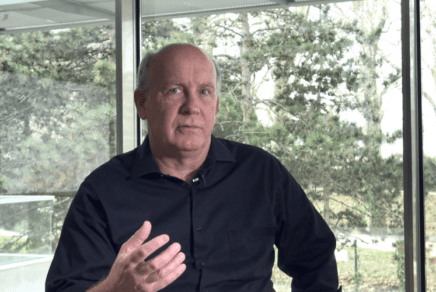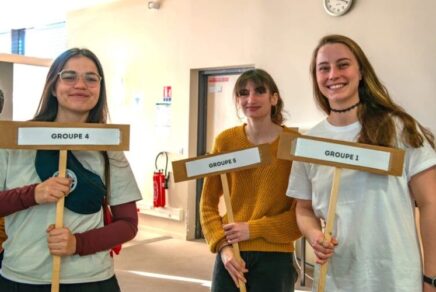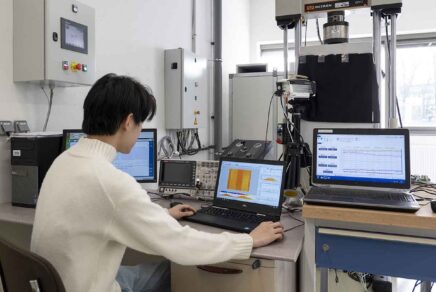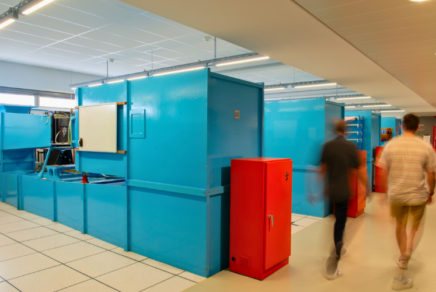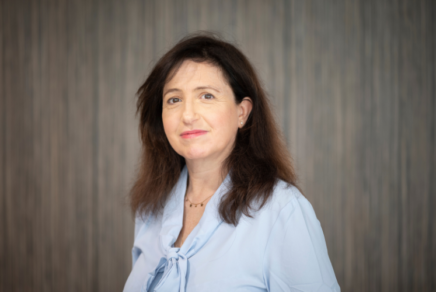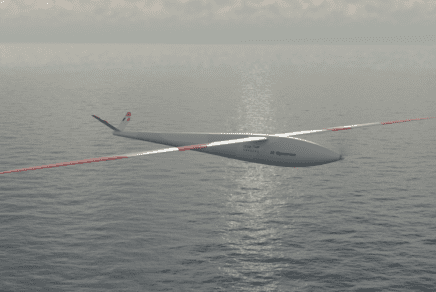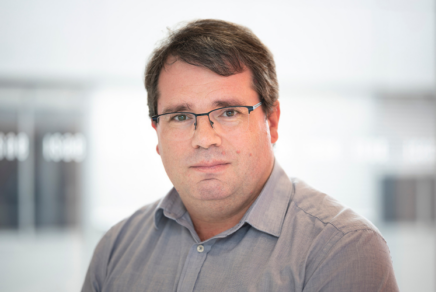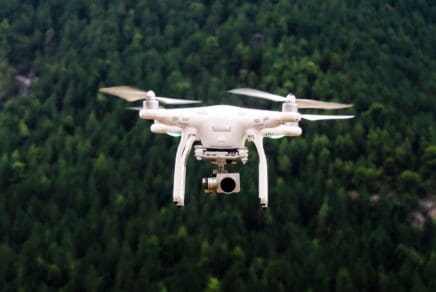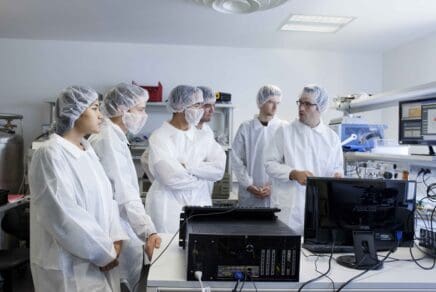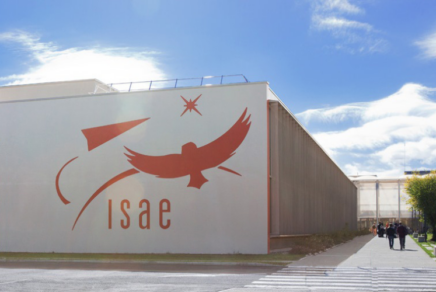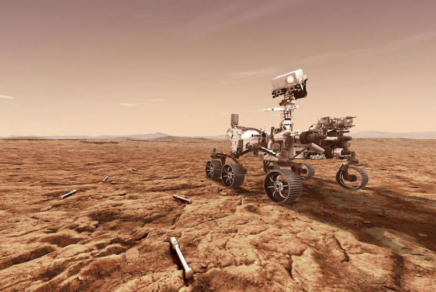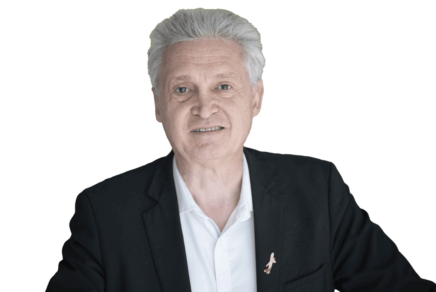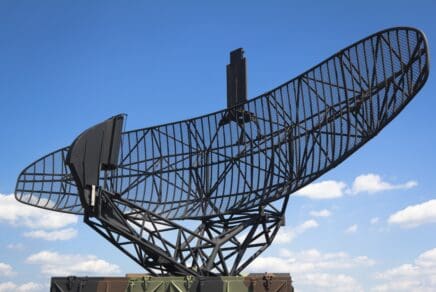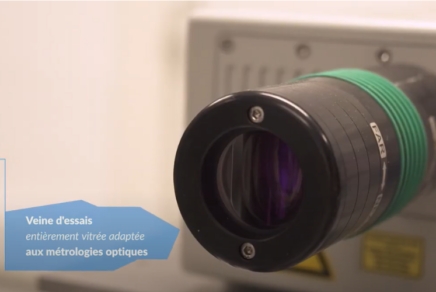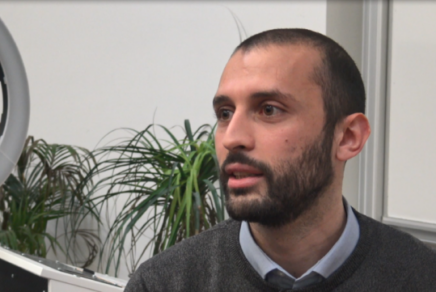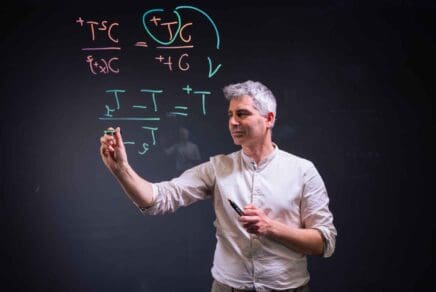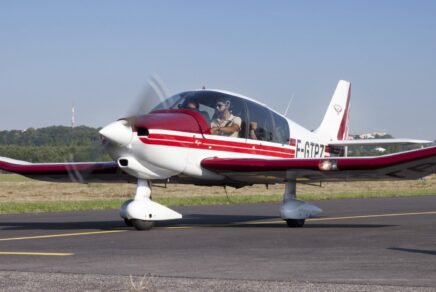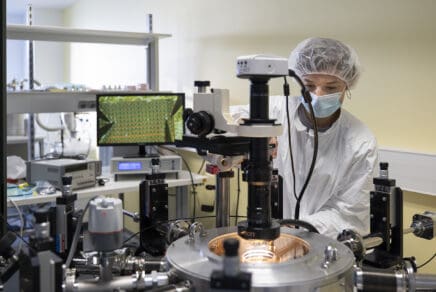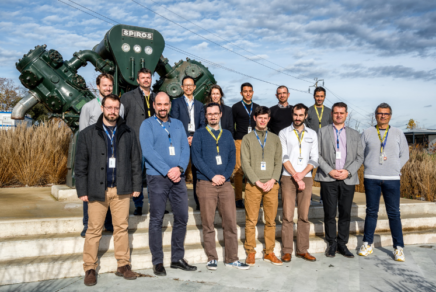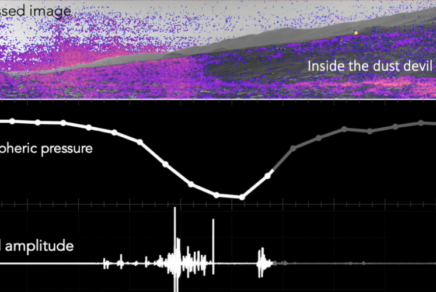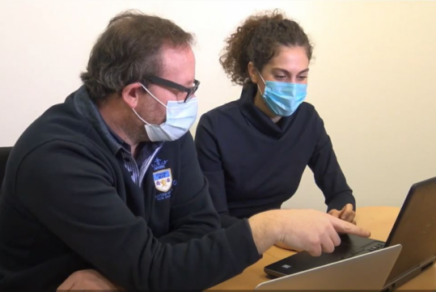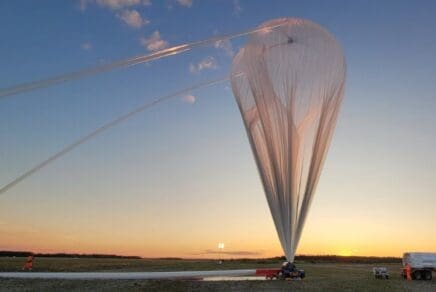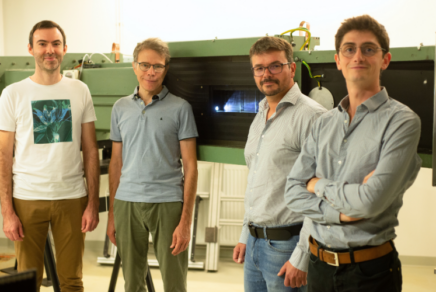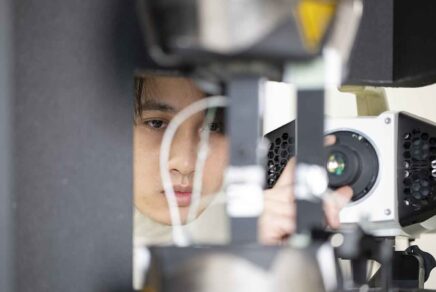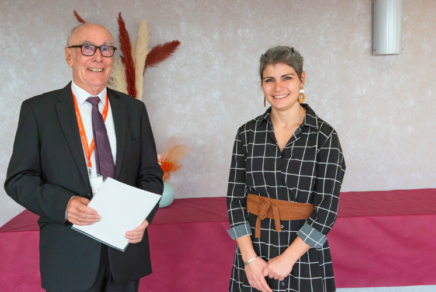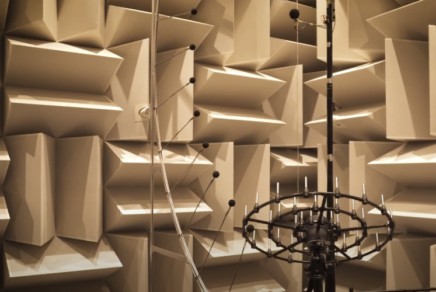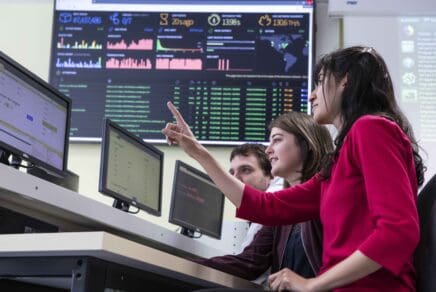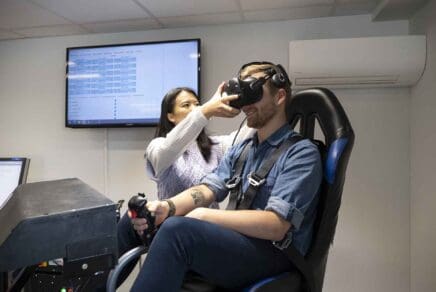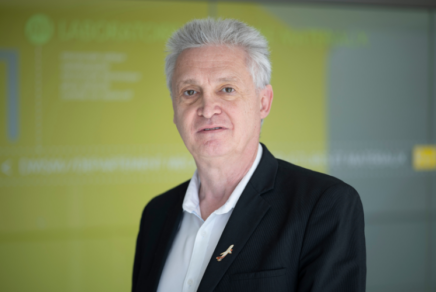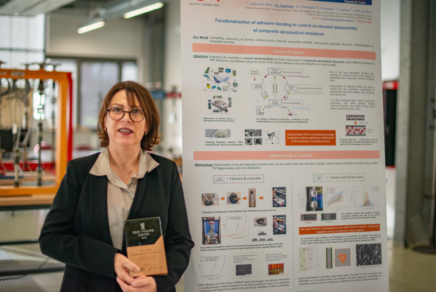À l’ISAE SUPAERO, le département Aérodynamique Énergétique et Propulsion : c’est 62 personnes, 30 projets de recherche dont 5 à échelle européenne, un parc exceptionnel de moyens d’essais à vocation pédagogique et de recherche, trois groupes de recherche contribuant à une stratégie de croissance tournée vers 4 thèmes aux enjeux scientifiques et sociaux-économiques d’actualité en s’appuyant sur 2 projets structurants : la soufflerie SAA et le code de simulation aux grandes échelles IC3.
Sur le même sujet
Actualités
Ensemble, engageons-nous durablement vers de nouveaux horizonsAéronautique
Défi
Développement Durable
Vidéos
La mission Dart a atteint sa cible : explications du Dr Naomi Murdoch, chercheuse en planétologie à l’ISAE-SUPAEROLa mission DART a atteint sa cible le 27 septembre à 1 h 14 du matin sur l’astéroïde Dimorphos ! Les chercheurs de l’ISAE-SUPAERO participent à cette première mission de défense planétaire. Le Dr. Naomi Murdoch - chercheuse à l’ISAE-SUPAERO et membre scientifique des missions DART et HERA - commente les objectifs de DART & ceux de la mission européenne HERA qui arrivera sur zone en 2026 pour caractériser le cratère laissé par DART et étudier la structure interne de l’astéroïde Dimorphos !
Chercheur
DEOS
Espace
Actualités
OPEN SCIENCE ISAE-SUPAERO : la science de l’ISAE-SUPAERO à ciel ouvert !L’ISAE-SUPAERO poursuit sa contribution au mouvement de la science ouverte et crée sa nouvelle plateforme d’archives ouvertes nommée OPEN SCIENCE ISAE-SUPAERO. Elle permet à tous d’accéder à nos thèses, publications, instruments scientifiques et plateformes technologiques.
Publication scientifique
Science
Thèse
Vidéos
L’ISAE-SUPAERO publie son Référentiel Aviation et ClimatLe référentiel Aviation et Climat de l’ISAE-SUPAERO a pour vocation de fournir des éléments #scientifiques utiles à la compréhension des enjeux sur l’aviation et le climat. Ces travaux ont été soumis à un processus de relecture spécifique, intégrant à la fois du personnel de l’ISAE-SUPAERO et des chercheurs extérieurs issus de différents instituts. Trois objectifs pour ce rapport : - Faire émerger une culture commune au sein de l'Institut sur ces questions - Soutenir les industriels dans leur stratégie de décarbonation - Alimenter les réflexions dans les débat autour de l'avenir du secteur aérien
Chercheur
Décarbonation
Développement Durable
Actualités
Les chercheurs de l’ISAE-SUPAERO explorent l’univers du quantiqueLa seconde révolution quantique est en marche ! L’ISAE-SUPAERO est déjà impliqué dans les recherches qui permettront l’avènement du quantique dans de nombreuses applications scientifiques et industrielles. Si aujourd’hui dans les laboratoires de recherche les travaux avancent pas à pas, les connexions entre les disciplines se renforcent. Aperçu des domaines en cours d’exploration.
Chercheur
DISC
Enseignant-chercheur
Vidéos
L’INSTRUMENT FRANÇAIS SUPERCAM ENREGISTRE LE SON DU 4èME VOL D’INGENUITYSitué à 80 mètres du rover au moment de son décollage, le petit hélicoptère s’est élevé à 5 mètres au-dessus du sol avant de parcourir une distance de 133 mètres pour ensuite revenir atterrir à l’endroit d’où il avait décollé. Le microphone scientifique de SuperCam, développé par l’ISAE-SUPAERO, a enregistré le son émis par la rotation des pales du drone martien au cours de son vol. Ce son possède une fréquence caractéristique de 84 Hz ; elle équivaut au « mi » grave d’un piano ou à la voix de basse d’un être humain. « C’est une grande surprise pour toute l’équipe scientifique ! » affirme Naomi Murdoch, chercheuse à l’ISAE-SUPAERO qui étudie les données du micro. « Les tests effectués dans un simulateur d’atmosphère martienne pour concevoir cet instrument et nos théories de la propagation du son nous indiquaient que le micro capterait très difficilement les sons de l’hélicoptère. En effet, l’atmosphère de Mars, très peu dense, atténue fortement la transmission des sons. Nous devions avoir un peu de chance pour enregistrer l’hélicoptère à une telle distance. Nous sommes très satisfaits d’avoir réussi à obtenir cet enregistrement qui se révèle une mine d’or pour notre compréhension de l’atmosphère martienne ». Développé conjointement par l’ISAE-SUPAERO et un consortium de laboratoires du CNRS et de ses partenaires, coordonnés par le CNES, le microphone de SuperCam est dérivé d’un modèle grand public adapté pour résister à l’environnement martien. Il poursuit 3 objectifs scientifiques et techniques substantiels de la mission Mars 2020 : L’étude du son associé aux impacts laser sur les roches martiennes pour mieux connaître leurs propriétés mécaniques. L’amélioration de la connaissance des phénomènes atmosphériques (turbulence du vent, tourbillons de poussière, interactions du vent avec le rover, et désormais, avec l’hélicoptère). La compréhension de la signature sonore des différents mouvements du rover (opérations du bras robotique et du mât, roulage sur sol normal ou accidenté, surveillance des pompes, …). Le microphone avait été mis en route pour la première fois quelques heures après l’atterrissage de Perseverance. Il avait alors enregistré les premiers sons martiens provenant de turbulences dans l’atmosphère. Il est utilisé quotidiennement en conjonction avec l’ablation laser des roches pour l’analyse chimique de Mars. À PROPOS DE LA MISSION MARS 2020 : La NASA s’appuie sur le Jet Propulsion Laboratory du Caltech pour le développement de la mission Mars 2020. SuperCam a été développé conjointement par le LANL (Los Alamos National Laboratory, États-Unis) et un consortium de laboratoires rattachés au CNRS, à des universités et établissements de recherche français. Plusieurs universités espagnoles, emmenées par l’université de Valladolid, contribuent aussi à cet instrument. Le CNES est responsable, vis-à-vis de la NASA, de la contribution française à SuperCam. L’instrument est opéré en alternance depuis le LANL et le centre des opérations scientifiques installé au CNES à Toulouse, le FOCSE (French Operations Center for Science and Exploration).
Chercheur
DEOS
Espace
Pages
Groupe scientifique « Mathématiques Appliquées » MALe groupe de recherche de Mathématiques Appliquées (MA) s’intéresse à des thématiques variées : processus stochastiques (notamment les processus de Markov), optimisation numérique (notamment multidisciplinaire) et calcul parallèle, stabilisation, contrôle et résolution numérique des équations aux dérivées partielles, et enfin l’ingénierie financière.
Chercheur
DISC
Doctorant
Vidéos
Sylvestre Maurice présente la mallette pédagogique SUPERCAM / Exploration MartienneLe projet de mallettes pédagogiques "SUPERCAM - exploration martienne" a été initié par 5 partenaires : l'ISAE-SUPAERO, l’Académie de Toulouse, le CNRS, le CNES et la Cité de l'espace. Sous l’impulsion et l’encadrement de l’astrophysicien Sylvestre Maurice, des étudiants de première année de l’ISAE-SUPAERO ont réalisé cet outil #éducatif de sensibilisation à l'exploration spatiale en classe, de la sixième à la Terminale. Cette mallette est mise à disposition des enseignants de collèges et lycées et permet, au travers de différentes adaptations, de proposer des séquences pédagogiques en lien avec cette thématique.
Chercheur
Égalité des chances
Espace
Vidéos
Essai en vol du drone Mermoz - 20 janvier 2023Courant janvier, le premier démonstrateur « Drone Mermoz » embarquant de l’hydrogène gazeux a effectué avec succès son premier vol radiocommandé sur la piste du club d’aéromodélisme de Muret en région toulousaine (31). Le démonstrateur, de 4 mètres d’envergure, présente un design inspiré des albatros qui exploitent les turbulences atmosphériques pour voler très longtemps en limitant leurs efforts. La route sera longue pour le « Défi Mermoz » qui ambitionne de réaliser, à l’horizon 2025, une traversée de l’Atlantique Sud sur la ligne mythique de l’Aéropostale reliant Dakar (Sénégal) à Natal (Brésil) ouverte par Jean Mermoz.
Aéronautique
Chercheur
DAEP
Pages
Groupe scientifique « Systèmes Spatiaux pour la Planétologie et ses Applications » (SSPA)Le groupe « Systèmes Spatiaux pour la Planétologie et ses Applications » (SSPA) se concentre sur un axe de recherche principal : le développement de missions et des technologies associées pour l’exploration géophysique du système solaire.
Chercheur
DEOS
Doctorant
Actualités
HACKATHON Sciences Des Données : l’IA en action !Du 24 au 26 février prochains, quarante-cinq étudiants exploreront trois sujets d’actualité faisant appel à l’Intelligence artificielle (IA) lors d’un hackathon de trois jours. Les équipes d’étudiants engagées tenteront de relever les défis posés par trois partenaires industriels sur les thèmes de l’environnement, l’industrialisation et la technologie de numérisation. L’ISAE-SUPAERO confirme son engagement dans la formation aux sciences des données et à l’intelligence artificielle à travers son parcours Sciences de la Décision et des Données (SDD).
Chercheur
Hackathon
IA
Actualités
MMX, Idefix® et des caméras pour comprendre la lune de MarsÉtudier la formation et l’origine des lunes de Mars et en ramener des échantillons : c’est la mission internationale hors norme, ambitieuse, menée par la JAXA, à laquelle participe l’ISAE-SUPAERO aux côtés du CNES.
Chercheur
DEOS
Espace
Témoignages
Témoignage de Stéphanie Lizy-Destrez, élue à l’Académie de l’Air et de l’EspaceÀ l’ISAE-SUPAERO, Stéphanie Lizy-Destrez dirige le SaCLaB, un laboratoire de recherche sur les systèmes spatiaux du futur. Professeure en ingénierie des systèmes spatiaux, elle vient d’être élue à l’Académie de l’Air et de l’Espace. Une reconnaissance par ses pairs d’une carrière aussi brillante qu’atypique au service d’une passion : l’exploration spatiale.
DCAS
Enseignant-chercheur
Espace
Actualités
L’ISAE-SUPAERO publie un référentiel Aviation et ClimatLe 18 octobre dernier, l’ISAE-SUPAERO a dévoilé son référentiel « Aviation et Climat » pour nourrir le débat de l’impact de l’aviation sur le réchauffement climatique. Ce document de référence synthétise les dernières publications scientifiques internationales, et fournit les éléments concrets nécessaires à la compréhension des enjeux de la décarbonation du transport aérien. Un rapport scientifique inédit pour permettre la construction d’opinions éclairées sur les enjeux et pistes d’innovation aviation et climat !
Développement Durable
Enseignant-chercheur
Pages
Groupe scientifique « Photonique Antenne Microondes PlasmA » (PAMPA)Le groupe « Photonique Antenne Microondes PlasmA » (PAMPA) s’intéresse à l’électromagnétisme dans les domaines des microondes et de la photonique ainsi qu’aux interactions ondes plasma.
Chercheur
DEOS
Doctorant
Actualités
La sonde Hera saisit des images exceptionnelles de Mars et de sa lune DeimosLa sonde Hera, mission internationale de défense planétaire, est en route pour étudier l’astéroïde Dimorphos, percuté par DART en 2022. L’ISAE-SUPAERO collabore activement à ce programme international de défense planétaire à travers les travaux de recherche de Naomi Murdoch et de l’équipe SSPA. Sur sa trajectoire, la sonde a réalisé, ce mercredi 12 mars 2025, un survol rapproché de la planète Mars et de sa lune Deimos pour en capturer des images exceptionnelles.
Chercheur
DEOS
Enseignant-chercheur
Vidéos
Retour d’expérience : un ingénieur Latecoere dans les laboratoires de l’ISAE-SUPAEROAfin de renforcer les liens entre industrie et recherche, plus de 10 ingénieurs industriels R&D ont été mis à disposition de l’ISAE-SUPAERO dans le cadre du plan France Relance ! Cyril Geneste, ingénieur de recherche chez Latecoere, en fait partie. Avec Miguel Charlotte, professeur associé à l’Institut, il revient sur cette collaboration fructueuse qui a duré deux ans. Leurs travaux, menés dans les laboratoires de l’ISAE-SUPAERO, ont porté sur le comportement des joints de porte des avions, qui assurent l’étanchéité de la cabine. Grâce aux équipements de pointe et à l’expertise académique de l’Institut, Cyril Geneste a notamment pu réaliser des modélisations numériques de joints afin d’en éprouver le comportement. Des élèves de 3ᵉ année du cursus ingénieur ont également été impliqués dans ces travaux.
Aéronautique
Chercheur
Vidéos
Professeurs invités à l'ISAE-SUPAERO : DAN SCHEERESL’ISAE-SUPAERO est un centre de formation par la recherche, de formation à la recherche et à l’innovation, pilotant ses activités pour obtenir un bon équilibre entre excellence scientifique, visibilité académique et proximité des finalités industrielles Ses activités de recherche ont contribué à faire de l’école un leader international, non seulement en termes de programme d’ingénierie aérospatiale, mais aussi de formations « post-graduate », notamment Master of Science (MSc), Mastère Spécialisé® et doctorat (PhD) dans le domaine de l’ingénierie aérospatiale. C’est pourquoi de nombreux acteurs internationaux de la recherche rendent visite à leurs homologues de l’ISAE-SUPAERO. Nous avons rencontré Dan Sheeres, professeur émérite de l’université du Colorado et titulaire de la chaire A. Richard Seebass au département des sciences de l’ingénierie aérospatiale Ann and H.J. Smead de l’université du Colorado Boulder. Les recherches de Dan Scheeres portent sur l’astrodynamique et la navigation des engins spatiaux, les sciences planétaires et la mécanique céleste. dans ces domaines. L’astéroïde 8887 est nommé "Scheeres" en reconnaissance de ses contributions à la compréhension scientifique de l’environnement dynamique des astéroïdes. Pendant son séjour à l’ISAE-SUPAERO, le professeur Scheeres et l’équipe "Systèmes spatiaux pour les applications planétaires" ont collaboré à l’analyse des données DART et au développement de concepts permettant de sonder la structure interne des astéroïdes lors de futures missions spatiales. En outre, Dan Scheeres et l’ISAE-SUPAERO ont publié conjointement plusieurs articles dans "Nature" sur les astéroïdes et la mission DART. https://www.nature.com/articles/s41586-023-05810-5 https://www.nature.com/articles/s41586-023-05878-z En savoir plus sur Dan Scheeres : https://www.colorado.edu/aerospace/daniel-scheeres En savoir plus sur DART : https://www.isae-supaero.fr/en/videos/the-dart-mission-reached-its-target-explanations-from-dr-naomi-murdoch/
Chercheur
DEOS
Espace
Pages
Groupe scientifique « Théorie, Modélisation et Ingénierie des Systèmes » (ThéMIS)Le groupe de recherche « Théorie, Modélisation et Ingénierie des Systèmes » (ThéMIS) se consacre à l’étude et au développement de méthodes avancées pour la conception, la modélisation et la validation des systèmes complexes.
Chercheur
DISC
Doctorant
Pages
L'Institute for Sustainable AviationCréé en 2021 à l’initiative d’institutions académiques de renommée internationale et dotées d’une expertise académique de longue date dans le domaine de l’aéronautique et du transport aérien, l’ISA est un institut dédié aux enjeux de la transition de l’aviation vers la durabilité.
Aéronautique
Aviation
Décarbonation
Actualités
Campus au féminin : sensibiliser les jeunes filles aux carrières scientifiquesJeudi 6 février et jeudi 13 mars 2025, L’ISAE-SUPAERO a accueilli près de 250 collégiennes et lycéennes des établissements de Toulouse et de la région Occitanie pour la journée Campus au féminin. Cet événement a pour objectif la sensibilisation des jeunes femmes aux métiers d’ingénieures à travers différents ateliers. Portée par le programme d’ouverture sociale de l’Institut OSE l’ISAE-SUPAERO et le club étudiant ISAElles, cette journée traduit l’engagement de l’ISAE-SUPAERO et de sa Fondation en faveur de l’égalité des chances.
Carrière
Échange
Égalité des chances
Pages
Le DMSM à l'Institut Clément Ader (ICA)L’Institut Clément Ader (UMR CNRS 5312) est le laboratoire de recherche en mécanique du solide de Toulouse et de sa région, sous l’égide du CNRS. Il fédère les équipes de recherche de quatre établissements et trois ministères : l’Université Toulouse III Paul Sabatier (Éducation Nationale), l’INSA (Éducation Nationale), l’ISAE-SUPAERO (Défense) et l’École des Mines d’Albi (Industrie). Ces établissements sont situés sur trois villes de Midi-Pyrénées, Toulouse, Albi et Tarbes.
Chercheur
DMSM
Doctorant
Actualités
Zoom sur les souffleries subsoniques, l’aérodynamique en pratiqueLes souffleries subsoniques de l’ISAE-SUPAERO permettent d’étudier les écoulements d’air sur un objet, comme un profil d’aile d’avion. Ces équipements, encadré par une équipe technique, sont utilisés aussi bien par les étudiants que par les chercheurs du département Aérodynamique, Énergétique et Propulsion (DAEP).
Aéronautique
DAEP
Vidéos
Découvrez... la plate-forme d’essais multidisciplinaire EMpEROR de l’ISAE-SUPAEROL'ISAE-SUPAERO - en tant que centre de formation par la recherche, de formation à la recherche et d’innovation - dispose de nombreux équipements de recherche utilisés au sein de ses 6 départements de recherche. Aujourd’hui, nous vous présentons la plateforme d’essais multidisciplinaire EMpEROR ! La plateforme EMpEROR est née de la prise en compte croissantes des phénomènes aéroélastiques dans l’aéronautique moderne, et de la synergie entre les départements Aérodynamique Energétique et Propulsion (DAEP), et Mécanique des Structures et Matériaux (DMSM). Cette plateforme a été conçue et réfléchie pour permettre une grande modularité de métrologie, autour d’un banc rotor permettant de faire tourner de 1 à 6 pales, jusqu’à 1 mètre de diamètre, de 0 à 3000 rpm en toute sécurité grâce à une cage de protection de 6 mètres de long. Elle est équipée de plusieurs capteurs pour les mesures de performance, et d’un système de vibrométrie rotative permettant la mesure de la dynamique des pales. Le banc permet d’embarquer des systèmes de mesure dans les pales, ainsi que des systèmes permettant de contrôler ces phénomènes instables. Depuis 2020, cette plateforme a également permis à deux étudiants en thèse et à 6 étudiants de Master de travailler sur les phénomènes aéroélastiques. Cette plateforme permet de générer des bases de données expérimentales utilisées par des chercheurs de l’ISAE-SUPAERO pour comparer et valider leurs codes de calcul. L’équipement montera en puissance en 2024 avec la possibilité de faire des mesures Laser, de type PIV ou/et LDV, ainsi que la possibilité de fabriquer des pales plus complexes avec la main sur la flexibilité de celles-ci.
DAEP
Actualités
Rencontre avec Stéphanie Lizy-Destrez, élue à l’Académie de l’Air et de l’EspaceÀ l’ISAE-SUPAERO, Stéphanie Lizy-Destrez dirige le SaCLaB, un laboratoire de recherche sur les systèmes spatiaux du futur. Professeure en ingénierie des systèmes spatiaux, elle vient d’être élue à l’Académie de l’Air et de l’Espace.
Disctinction
Enseignant-chercheur
Espace
Actualités
Le projet d’un avion sans pilote, zéro émission pour traverser l’Atlantique SudLe projet Drone Mermoz, initié par une équipe de chercheurs du laboratoire d’aérodynamique de l’ISAE-SUPAERO a pour ambition de participer au développement de technologies de rupture pour l’aviation électrique. Traverser l’Atlantique Sud avec un aéronef d’environ 4 mètres d’envergure sans pilote et à propulsion hydrogène représenterait un premier pas vers le développement d’avions bas-carbone de plus grande taille pour le transport aérien.
Chercheur
Développement Durable
Innovation
Actualités
Zoom sur… la physique quantique dans les formations à l’ISAE-SUPAEROL’ISAE-SUPAERO intègre de façon ininterrompue depuis 1980 la physique quantique dans ses activités de formation et de recherche et propose depuis deux décennies des enseignements liés à la seconde révolution quantique.
DEOS
Enseignant-chercheur
Ingénieur généraliste
Pages
Groupe scientifique « Conception et Analyse des Systèmes Critiques » CASCLe groupe « Conception et Analyse des Systèmes Critiques » (CASC) s’intéresse aux méthodes, processus et outils supports à l’Ingénierie Système et l’Ingénierie des Systèmes.
Chercheur
DISC
Doctorant
Pages
Groupe scientifique « Apprentissage, Décision, Optimisation » (ADO)Le groupe de recherche « Apprentissage, Décision, Optimisation » (ADO) s’intéresse à l’aide à la décision pour des applications allant des systèmes autonomes (planification, apprentissage, supervision) aux systèmes industriels (conception, développement, opérations, etc.).
Chercheur
DISC
Doctorant
Pages
La recherche à l'ISAE-SUPAEROÀ l’ISAE-SUPAERO, nous menons une recherche d’excellence au service de l’innovation, de la souveraineté technologique et de la transition écologique du secteur aérospatial, affirmant ainsi notre rôle d’acteur de référence dans la communauté scientifique et industrielle.
Chercheur
DAEP
DCAS
Actualités
Félicitations à nos 8 enseignants-chercheurs de l’ISAE-SUPAERO qui font partie des 2% des scientifiques les plus performants !L’université de Stanford a récemment publié une mise à jour de la liste des scientifiques les plus influents dans le monde et dans laquelle figurent 8 enseignants chercheurs de l’ISAE-Supaero.
Classement
Enseignant-chercheur
Vidéos
Perseverance recueille les premiers sons martiens : explications par les Dr. Naomi Murdoch & Dr Alexander StottDr Naomi Murdoch, chercheuse en instrumentation spatiale et science planétaire et le Dr Alexander Stott, post-doctorant, nous en disent plus sur les caractéristiques physiques de l’atmosphère de Mars, en particulier sur la vitesse du son et son atténuation. Ces analyses ont fait l’objet d’une publication dans la revue Nature le 1er avril 2022 par une équipe internationale dirigée par un enseignant-chercheur de l’Université Toulouse III – Paul Sabatier et regroupant des scientifiques du CNRS et de l’ISAE-SUPAERO.
Chercheur
DEOS
Espace
Témoignages
Témoignage d'Yves Gourinat, élu membre titulaire à l’Académie de l’Air et de l’EspaceYves Gourinat est professeur de physique des structures au sein du département Mécanique des Structures et Matériaux (DMSM) à l’ISAE-SUPAERO. Déjà membre correspondant depuis 2019, il vient d’être élu membre titulaire de l’Académie de l’Air et de l’Espace.
DMSM
Enseignant-chercheur
Structures et matériaux
Pages
Groupe scientifique « Communication et théorie de l’InformaTion » (ComIT)Le groupe « Communication et théorie de l’InformaTion » (ComIT) intervient dans les disciplines des communications numériques, du radar, des techniques d’accès aux canaux. Ses domaines applicatifs s’articulent autour des systèmes spatiaux, de l’aviation civile et militaire, des réseaux cellulaires terrestres et de l’Internet des objets (IoT).
Chercheur
DEOS
Doctorant
Pages
Groupe scientifique SysCoLa dynamique scientifique du groupe de recherche « Systèmes Connectés » (SysCo) se focalise principalement sur les problématiques concernant les réseaux dans les domaines d’applications liés à l’aéronautique et à l’espace, c'est-à-dire les communications spatiales, les réseaux embarqués et certains types de systèmes connectés.
Chercheur
DISC
Doctorant
Vidéos
Découvrez... la soufflerie de visualisation de l’ISAE-SUPAEROLa soufflerie de visualisations est la seule soufflerie à conduit ouvert du département. Contrairement aux souffleries à conduit de retour, dans lesquelles l’air recircule dans le conduit, ici l’air est capté à l’extérieur du bâtiment, circule dans la soufflerie puis est évacué à l’extérieur grâce à un compresseur centrifuge à aspiration placé en sortie de la soufflerie. Cette soufflerie est ainsi particulièrement adaptée à l’étude des pertubations d’écoulement : les pertubations maitrisées et bien qualifiées générées dans la veine d’essais sont ensuite évacuées sans venir modifier les conditions entrantes dans la soufflerie. La veine d’essais de la soufflerie mesure 45 cm de côté et 3 m de long. Les vitesses peuvent atteindre 35 m/s. Sans aucune pertubation, la géométrie et traitement du conduit (filtres, nid d’abeilles et grilles fines) garantissent une bonne homogénéité spatiale et temporelle de l’écoulement qui présente un taux de turbulence voisin de 0.3%. Ici, des volets oscillants sont placés en extrémité de veine d’essai pour générer des variations temporelles quasi-sinusoïdales maîtrisées de la vitesse de l’écoulement. Les pertes de charges associées à la fermeture des volets peuvent assurer une perte violente de plus de 50% de la vitesse longitudinale. De telles perturbations aérologiques peuvent être enregistrées au cours d’un vol de faible altitude, particulièrement en environnement urbain pour lequel la présence de bâtiments accentue l’intensité des fluctuations du vent apparent. Ainsi, un drone évoluant à une dizaine de m/s est susceptible de rencontrer des rafales de vent de grande extension spatiale et d’amplitude similaire à sa propre vitesse d’avancement. Les propriétés et les effets de la turbulence atmosphérique sur les performances en vol de ces aeronefs légers, de petites tailles et de faible vitesse d’avancement sont donc très différents de ce qui est classiquement connu pour des avions de lignes. L’enjeu est de concevoir des drones, microdrones, nanodrones robustes aux rafales de vent. Nous étudions actuellement la réponse aérodynamique instationnaire d’une aile soumise à une variation sinusoïdale du vent incident. Les dimensions de l’aile et vitesses étudiées sont représentatives d’un vol de microdrone en environnement urbain. Les propriétés désirées de la rafale de vent sont assurés par un pilotage adapté des volets oscillants. L’écoulement instationnaire est caractérisé finement à l’aide d’une sonde fil chaud placée en entrée de veine d’essai. La rafale retenue présente une vitesse moyenne de 10m/s avec des variations de +/- 4m/s sur une période de 0.8 s. Nous mesurons les performances globales aérodynamiques en relevant les évolutions temporelles des efforts de portance, traînée et moment de tangage pour différents angles d’incidence de vol. Pour analyser l’origine de ces performances, il faut bien qualifier et comprendre la physique de l’écoulement autour de la maquette et sa réponse face aux variations de vitesse incidente. La Vélocimétrie par Images de Particules (PIV), fournit les champs de vitesses instantanés de l’écoulement. Par un post-traitement adapté, nous pouvons en extraire la dynamique de l’écoulement lors des rafales de vent.
DAEP
Vidéos
Découvrez le portrait de Paolo PANICUCCI doctorant à l’ISAE-SUPAEROPaolo a mené sa thèse au sein du Département Ingénierie des Systèmes Complexes (DISC). Son intitulé est : Navigation basée vision autonome et reconstruction de forme d’un astéroïde inconnu pendant la phase d’approche. Il est rattaché à l’école doctorale AA - Aéronautique Astronautique. L’ISAE-SUPAERO accueille ses doctorants au sein de six équipes à l’ISAE-SUPAERO, ONERA et à l’institut Clément Ader, couvrant un large spectre de disciplines scientifiques liées au domaine aéronautique et espace : aérodynamique et propulsion, structures et matériaux, systèmes embarqués, réseaux et télécommunications, contrôle et conduite des systèmes, facteurs humains, électronique, signal. L’ISAE-SUPAERO offre un programme riche et diversifié de formation doctorale, conduisant au doctorat, diplôme de plus haut niveau délivré par l’institut, et reconnu au niveau international. Lien vers sa thèse : http://www.theses.fr/s253653
Doctorat
Thèse
Pages
Département Langues, Arts, Cultures et SociétésAu LACS, nous enseignons les langues, l’interculturalité, la géopolitique, la culture générale, l’économie, le sport… Des compétences pluridimensionnelles qui font émerger le savoir, le savoir-être, le savoir-faire et le savoir-agir.
Chercheur
Doctorat
Enseignant-chercheur
Pages
Intégrité scientifique et de rechercheL’ISAE-SUPAERO est l’un des établissements signataires de la Charte nationale de déontologie des métiers de la recherche, adoptée en janvier 2015 par la Conférence des Présidents d’Université (CPU) et l’ensemble des organismes nationaux de recherche, et intégrée au règlement intérieur de l’Institut.
Chercheur
DAEP
DCAS
Pages
Centre des Opérations Aériennes de LasbordesLe Département Conception et Conduite des véhicules Aéronautiques et Spatiaux (DCAS) intègre le Centre des Opérations Aériennes de Lasbordes (COAL) situé sur un aérodrome à quelques kilomètres du campus de L’ISAE-SUPAERO. Dans le cadre de ses activités de formation et de recherche aéronautique, le COAL opère une flotte de 9 avions légers.
Chercheur
DCAS
Doctorant
Pages
Groupe scientifique « Capteurs d’IMages Intégrés » (CIMI)Le groupe « Capteurs d’IMages Intégrés » (CIMI) étudie, développe et caractérise des capteurs d’images à pixels actifs (Capteurs CMOS Image Sensor (CIS)) sur silicium pour le rayonnement visible et l’infrarouge.
Chercheur
DEOS
Doctorant
Actualités
Systèmes de conditionnement d’air : l’ISAE-SUPAERO et Liebherr-Aerospace Toulouse unissent leurs effortsL’ISAE-SUPAERO et Liebherr-Aerospace Toulouse ont renforcé leur collaboration le 1er janvier dans le cadre d’une chaire industrielle. L’objectif ? Développer et à améliorer les méthodes et les outils de conception aérodynamique des roues de turbomachines, participant à la recherche sur l’avion décarboné.
Chaire
DAEP
Partenariat
Pages
Notre écosystèmeNotre Institut évolue au cœur d’un écosystème académique, scientifique et technologique de premier plan. L'ISAE-SUPAERO entretient des partenariats solides avec un large éventail d’acteurs académiques, industriels, socio-économiques et institutionnels, tant au niveau régional, national qu’international. Notre Institut joue notamment un rôle actif au sein de sociétés savantes et de réseaux scientifiques, consolidant ainsi notre influence et notre expertise dans le secteur aéronautique et spatial.
Aérospatial
Partenaire
Science
Vidéos
Le son d’un tourbillon de poussière martien capturé par le microphone de SuperCam sur PersévéranceCette vidéo et cet audio montrent les résultats obtenus par le rover martien Persévérance de la NASA et son microphone SuperCam lors de l’enregistrement des sons d’un tourbillon de poussière martien passé à sa verticale le 27 septembre 2021, le 215e jour martien ou sol, de la mission. Le tourbillon de poussière mesurait 25 mètres de large pour au moins 118 mètres de haut, et se déplaçait à 19 km/h environ. C’est la première fois qu’un tel enregistrement est réalisé, car capturer un tourbillon de poussière demande un peu de chance. En effet, il a survolé le rover au moment où tous les capteurs de Persévérance mesurant le vent, la pression, la température et la poussière plus la caméra NavigationXXX (Navcam) étaient en marche. Cela a permis aux scientifiques de combiner les sons, les images et les données atmosphériques. La combinaison unique de ces données, ainsi que la modélisation atmosphérique, ont permis aux chercheurs d’estimer les dimensions du tourbillon de poussière. Les scientifiques ne peuvent pas prédire précisément le passage de ces vortex. Les rovers comme Persévérance et Curiosity les surveillent régulièrement. Lorsque les scientifiques constatent qu’ils sont plus fréquents à un certain moment de la journée ou qu’ils s’approchent d’une certaine direction, ils concentrent leur surveillance pour tenter d’attraper un tourbillon de poussière avec tous les capteurs à leur disposition. > Pour mieux comprendre la vidéo, elle montre trois rangées d’images : - la rangée du haut est une image brute de la surface martienne prise par la NavcamSuperCam ; bien que la caméra soit capable de prendre des couleurs, elle prend des images en noir et blanc lorsqu’elle recherche des tourbillons de poussière afin de réduire la quantité de données renvoyées vers la Terre (la plupart des images reviennent sans tourbillon de poussière détecté). - la rangée du milieu montre la même image traitée avec un logiciel de détection des changements pour indiquer où le mouvement s’est produit au fil du temps ; la couleur est utilisée pour montrer la densité de la poussière, allant du bleu (bruit à la poussière de faible densité) au jaune en passant par le violet. Les zones où le mouvement est détecté sont indiquées par la couleur, le violet correspondant à un mouvement léger et le blanc à un mouvement plus rapide. - la dernière ligne est un graphique montrant l’amplitude du son provenant du microphone de SuperCam et une chute soudaine de la pression atmosphérique enregistrée par la suite de capteurs de Perseverance, appelée Mars Environmental Dynamics Analyzer, fournie par le Centro de Astrobiología (CAB) à l’Instituto Nacional de Tecnica Aeroespacial à Madrid et l’amplitude du son provenant du microphone de SuperCam . Un objectif clé de la mission de Persévérance sur Mars est l’astrobiologie, notamment la recherche de signes de vie microbienne ancienne. Le rover caractérisera la géologie et le climat passé de la planète, ouvrira la voie à l’exploration humaine de la planète rouge et sera la première mission à collecter et à mettre en cache de la roche et du régolithe martiens (roche brisée et poussière).
Chercheur
DEOS
Espace
Vidéos
Découvrez le portrait d’Anthéa COMELLINI doctorante à l’ISAE-SUPAEROAnthéa a mené sa thèse au sein du Département Ingénierie des Systèmes Complexes (DISC). Son intitulé est : « Rendez-vous autonomes basés vision avec cibles non coopératives ». Anthéa est rattachée à l’école doctorale AA - Aéronautique Astronautique. Sa thèse réalisée en collaboration avec Thales Alenia Space fait partie du dispositif CIFRE* L’ISAE-SUPAERO accueille ses doctorants au sein de six équipes à l’ISAE-SUPAERO, ONERA et à l’institut Clément Ader, couvrant un large spectre de disciplines scientifiques liées au domaine aéronautique et espace : aérodynamique et propulsion, structures et matériaux, systèmes embarqués, réseaux et télécommunications, contrôle et conduite des systèmes, facteurs humains, électronique, signal. L’ISAE-SUPAERO offre un programme riche et diversifié de formation doctorale, conduisant au doctorat, diplôme de plus haut niveau délivré par l’institut, et reconnu au niveau international. *Depuis 1981, le dispositif CIFRE - Conventions Industrielles de Formation par la REcherche - permet à l’entreprise de bénéficier d’une aide financière pour recruter un jeune doctorant dont les travaux de recherche, encadrés par un laboratoire public de recherche, conduiront à la soutenance d’une thèse en trois ans. Les CIFRE sont intégralement financées par le ministère de l’Enseignement supérieur et de la Recherche qui en a confié la mise en œuvre à l’ANRT (Association Nationale de la Recherche et de la Technologie).
Doctorat
Thèse
Pages
Notre annuaireAnnuaire
Enseignant-chercheur
Vidéos
Sylvestre Maurice, astrophysicien et Alumni de l’ISAE-SUPAERORécompensé par l'Académie des sciences en 2020, Sylvestre Maurice #astrophysicien à l’Institut de Recherche en Astrophysique et Planétologie (IRAP) à Toulouse a assisté le 18 février 2021 à l’atterrissage du rover #Perseverance sur Mars. Un moment historique pour ce passionné qui est aussi le responsable scientifique de l’instrument embarqué SuperCam. Diplômé de l’ISAE-SUPAERO en 1990, Sylvestre Maurice nous raconte son parcours.
Alumni
Chercheur
Espace
Actualités
Percer les secrets des séismes à l’aide de ballons stratosphériquesUne équipe de chercheurs du DEOS a franchi une étape significative dans l’utilisation des données infrasonores captées par des ballons stratosphériques pour la compréhension des signaux sismiques. Cette avancée, publiée dans Earth Planets Space*, ouvre de nouvelles perspectives pour l’étude des séismes, tant sur la Terre que sur d’autres planètes.
Chercheur
DEOS
Science
Actualités
À l’écoute du passé martien : l’ISAE-SUPAERO au cœur de la mission ExoMarsLa mission ExoMars Rosalind Franklin de l’ESA dédiée à l’exploration de Mars embarquera un instrument unique d’enregistrement du son et des données atmosphériques de la planète Mars. L’Institut a été sélectionné par l’ESA et le CNES pour cette collaboration scientifique d’envergure.
Chercheur
DEOS
Enseignant-chercheur
Actualités
Prix du meilleur article scientifique décerné par l’American Institute of Aeronautics and Astronautics 2024 Multidisciplinary Design OptimizationSix chercheurs de l’ISAE-SUPAERO, de l’EPFL et de l’Université des sciences et technologies de Hong Kong se sont vu décerner le prix du meilleur article scientifique par l’AIAA pour leur article : “DeepGeo : Deep Geometric Mapping for Automated and Effective Parameterization in Aerodynamic Shape Optimization”.
Chercheur
Prix
Publication scientifique
Actualités
Un protocole choisi pour sécuriser les communications face aux ordinateurs quantiquesLe NIST (National Institute of Standards and Technology), organisme de normalisation américain, a sélectionné HQC (Hamming Quasi-Cyclic), un protocole développé par des chercheurs de l’ISAE-SUPAERO, de l’ENAC et de l’Université de Limoges, pour faire face aux futures menaces des ordinateurs quantiques. Ce protocole devrait permettre d’assurer la sécurité des échanges numériques pendant des décennies.
Chercheur
DISC
Enseignant-chercheur
Actualités
Propulsion ionique, genèse d’une recherche émergenteNicolas Binder est professeur et chef du groupe de recherche Turbomachine et Propulsion à l’ISAE-SUPAERO. Il mène pour l’Institut, en collaboration avec des partenaires académiques européens, le projet IPROP, pour Ionic Propulsion In Atmosphere.
DAEP
Pages
Département Mécanique des Structures et MatériauxLe Département Mécanique des Structures et Matériaux a pour vocation d’organiser et de superviser l’ensemble des activités d’enseignement de la mécanique du solide déformable pour les formations de l’ISAE-SUPAERO, en synergie avec les activités recherche amont et appliquées sur les matériaux et les structures aéronautiques. Cette interaction forte entre enseignement et recherche est le socle de l’organisation de notre département.
Chercheur
DMSM
Doctorat
Actualités
Noémie Martin, ingénieure E2018, reçoit le prix d’1 M€ de la Fondation Jean-Jacques et Félicia Lopez-Loreta pour son projet FASTENoémie Martin, ingénieure ISAE-SUPAERO (ENSICA), diplômée en 2018, a été récompensée par la Fondation Lopez-Loreta en novembre 2024 pour son projet FASTE : Fabrication Additive des Structures performantes multi maTériaux pour utilisation en Environnement sévère.
Ouverture sociale
Prix
Science
Vidéos
Découvrez... la chambre anéchoïque acoustique de l’ISAE-SUPAERODepuis 2017, le Département d’Aérodynamique, Énergétique et Propulsion (DAEP) de l’ISAE-SUPAERO dispose d’une chambre anéchoïque, salle d’expérimentation acoustique dont l’ensemble des parois est traité pour étudier le bruit généré par des équipements en l’absence de réflexion des ondes acoustiques. Le DAEP utilise ce moyen d’essai pour étudier le bruit d’origine aérodynamique généré par exemple par des hélices de drone afin de pouvoir proposer et tester des stratégies de réduction. Les essais réalisés dans cette installation permettent également le développement de nouvelles méthodologies expérimentales et la validation des codes de simulation numérique développés au département.
DAEP
Pages
Département d’ingénierie des systèmes complexesAu sein de l’ISAE-SUPAERO, le Département d’ingénierie des systèmes complexes (DISC) développe des compétences en mathématiques et informatique pour l’ingénierie aéronautique et spatiale. En enseignement comme en recherche, il s’intéresse aux modèles, méthodes et outils nécessaires pour maîtriser le comportement et les performances de systèmes complexes. Cette complexité peut être induite par le caractère multi-physiques ou multi-échelles des systèmes étudiés, leur comportement dynamique, leur structure distribuée et communicante.
Chercheur
DISC
Doctorat
Pages
Département Conception et Conduite des véhicules Aéronautiques et SpatiauxÀ l'ISAE-SUPAERO, le Département Conception et Conduite des véhicules Aéronautiques et Spatiaux (DCAS) développe des méthodes, des outils de simulation et des plateformes expérimentales pour la conception et la conduite de véhicules aéronautiques et spatiaux.
Chercheur
DCAS
Doctorat
Actualités
Rencontre avec Yves Gourinat, élu membre titulaire à l’Académie de l’Air et de l’EspaceYves Gourinat est professeur de physique des structures au sein du département Mécanique des Structures et Matériaux (DMSM) à l’ISAE-SUPAERO. Déjà membre correspondant depuis 2019, il vient d’être élu membre titulaire de l’Académie de l’Air et de l’Espace.
Aéronautique
Disctinction
Enseignant-chercheur
Actualités
L’équipe de recherche SA-I du DMSM a reçu le prix du meilleur poster lors de la 14ème conférence EASNPlusieurs chercheurs du DMSM ont reçu le prix du meilleur poster lors de la 14ᵉ conférence EASN (European Aeronautic Science Network) dédiée cette année à la thématique « Innovation in Aviation & Sace towards sustainability today & tomorrow » !
Chercheur
Conférence
Prix
Pages
Groupe scientifique « Navigation, Radar and Remonte Sensing » (NAVIR²eS)Le groupe « Navigation, Radar and Remonte Sensing » (NAVIR²eS) s’intéresse à l’étude théorique des sources d’information ainsi qu’aux approches d’hybridation dans le cadre d’application de navigation autonome de véhicules.
Chercheur
DEOS
Doctorant


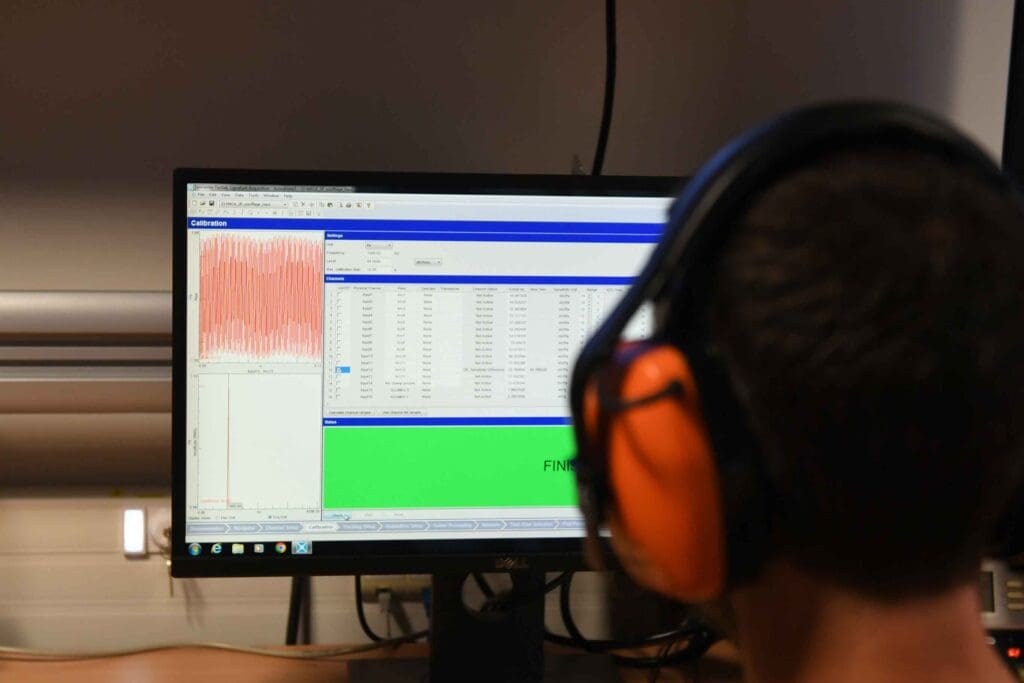
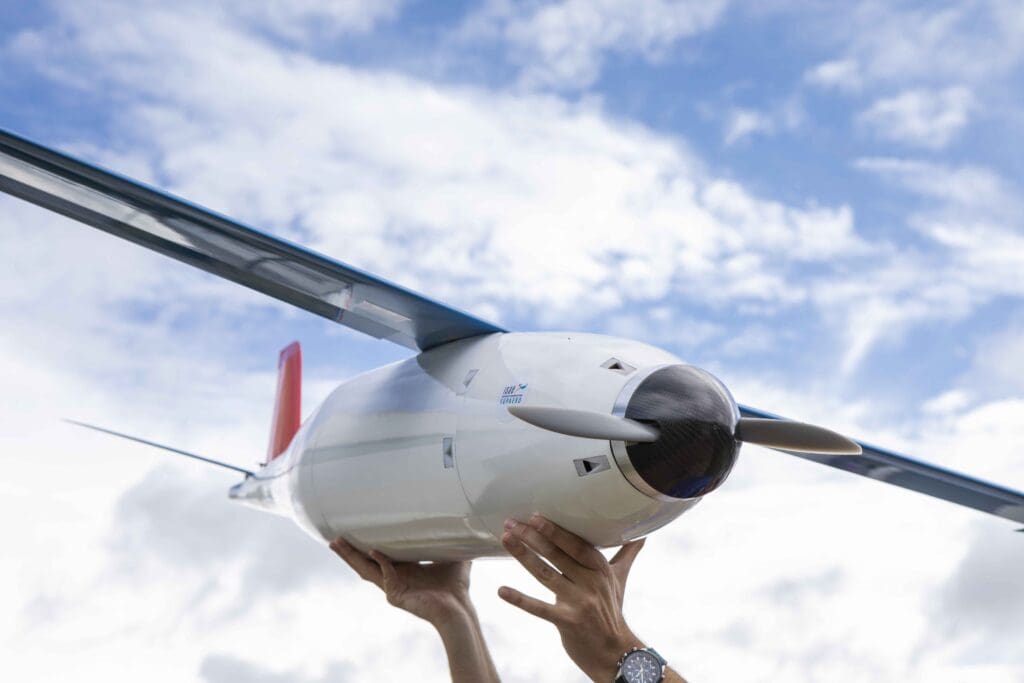
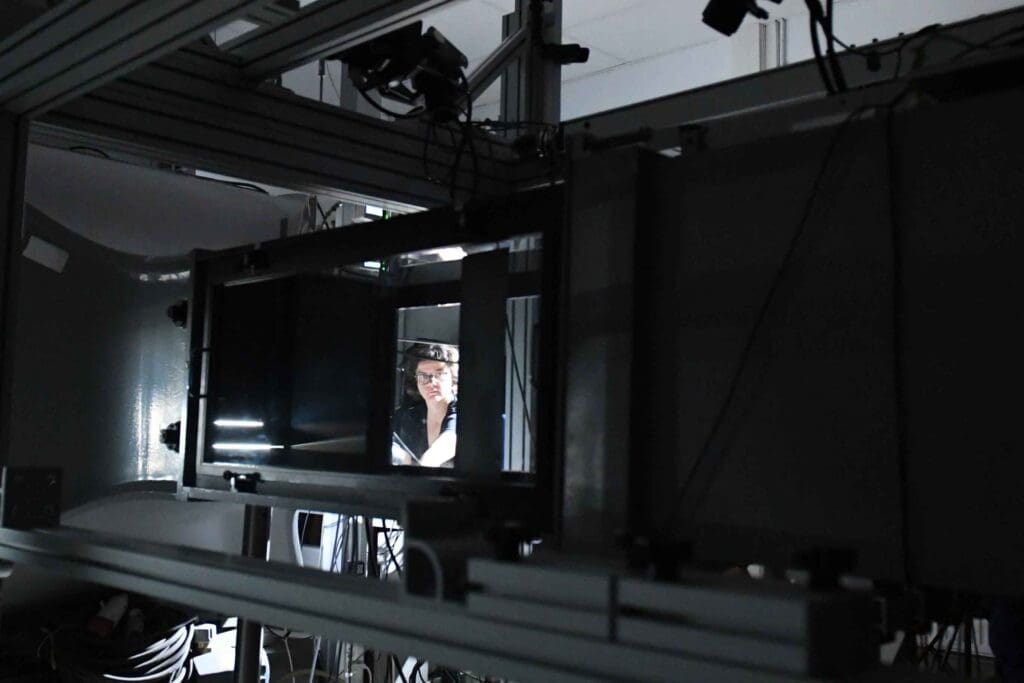
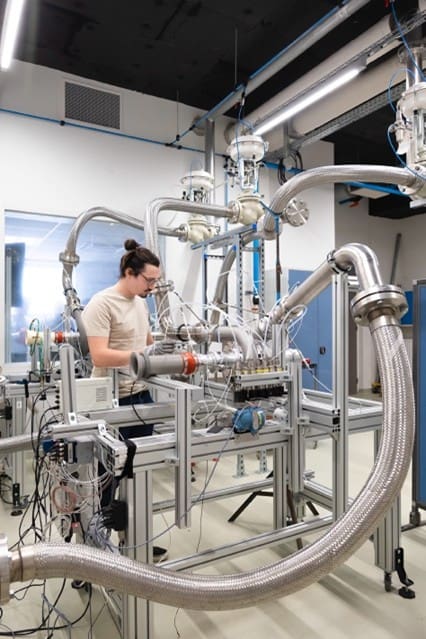 L’adaptation aux énergies non carbonées exige des évolutions importantes dans l’architecture des systèmes de transports. Pour un avion, de nombreux sous-systèmes tels que l’unité de propulsion ou de conditionnement d’air sont concernés. Ces évolutions se déclinent au niveau des composants, et se heurtent aux limitations de certains d’entre eux, telles que les turbomachines qui les composent. Ainsi, le processus d’électrification requiert des plages de fonctionnement à haut rendement des turbines et compresseurs qui se situent au-delà de l’état de l’art actuel. L’alimentation en air des piles à combustible rencontre les mêmes difficultés, ce qui bloque les développements.
L’adaptation aux énergies non carbonées exige des évolutions importantes dans l’architecture des systèmes de transports. Pour un avion, de nombreux sous-systèmes tels que l’unité de propulsion ou de conditionnement d’air sont concernés. Ces évolutions se déclinent au niveau des composants, et se heurtent aux limitations de certains d’entre eux, telles que les turbomachines qui les composent. Ainsi, le processus d’électrification requiert des plages de fonctionnement à haut rendement des turbines et compresseurs qui se situent au-delà de l’état de l’art actuel. L’alimentation en air des piles à combustible rencontre les mêmes difficultés, ce qui bloque les développements.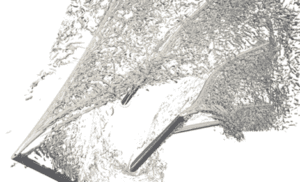 C’est ainsi une équipe d’une vingtaine de personnes, sur les deux sites, et une mise en commun de moyens d’essais, qui contribuent à ce projet de 4 ans. Le financement de 1,25 M€ des couts directs est assuré pour moitié par l’ANR et pour moitié par Liebherr. Le gain de flexibilité attendu des turbomachines radiales aidera à répondre aux exigences d’électrification des aéronefs. Il contribuera également au développement de piles à combustible ou de cycles de récupération de chaleur. Il favorisera l’émergence de nouvelles architectures de systèmes, qui pourront infuser d’autres secteurs industriels.
C’est ainsi une équipe d’une vingtaine de personnes, sur les deux sites, et une mise en commun de moyens d’essais, qui contribuent à ce projet de 4 ans. Le financement de 1,25 M€ des couts directs est assuré pour moitié par l’ANR et pour moitié par Liebherr. Le gain de flexibilité attendu des turbomachines radiales aidera à répondre aux exigences d’électrification des aéronefs. Il contribuera également au développement de piles à combustible ou de cycles de récupération de chaleur. Il favorisera l’émergence de nouvelles architectures de systèmes, qui pourront infuser d’autres secteurs industriels. Contexte et objectifs de recherche
Contexte et objectifs de recherche 